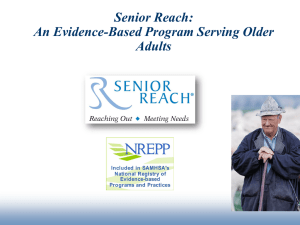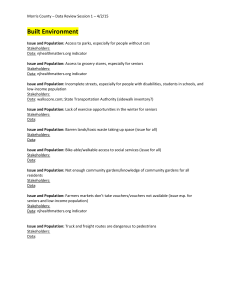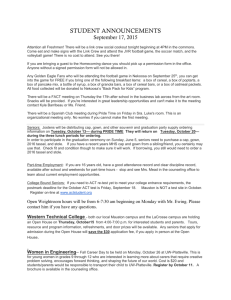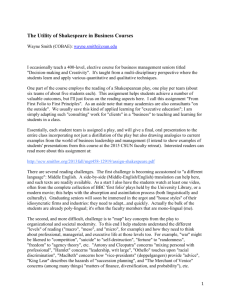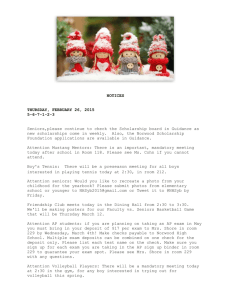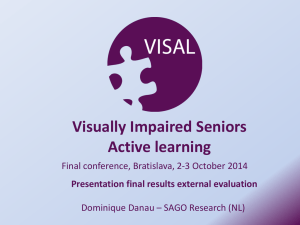An Innovative, Collaborative Model Meeting the
advertisement
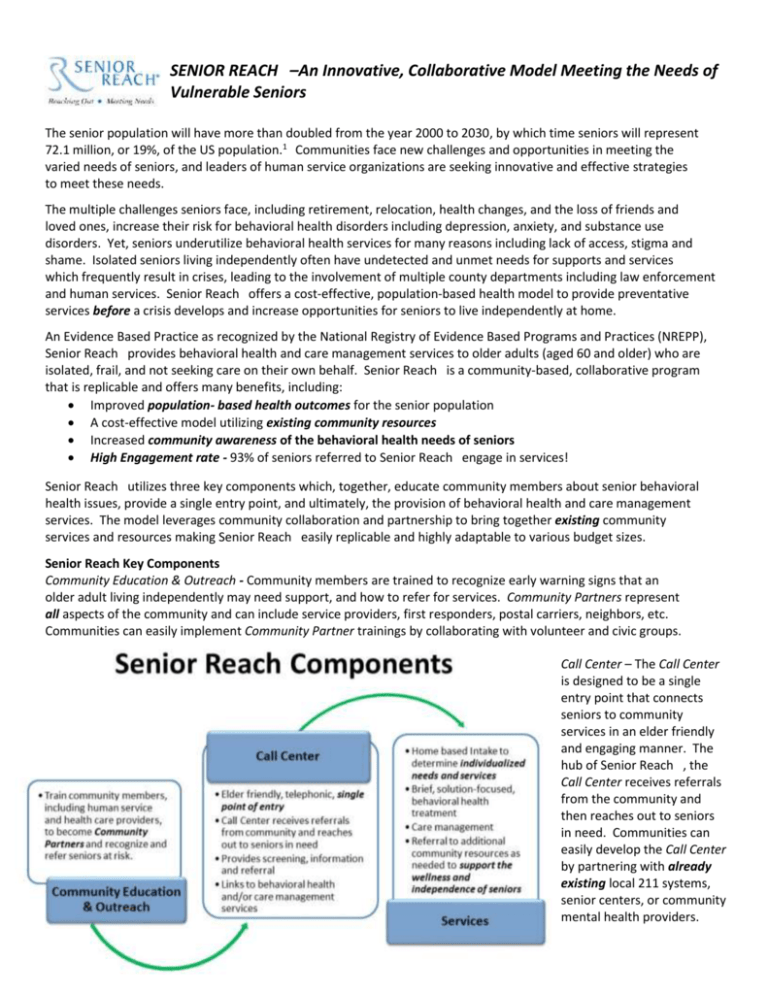
SENIOR REACH –An Innovative, Collaborative Model Meeting the Needs of Vulnerable Seniors The senior population will have more than doubled from the year 2000 to 2030, by which time seniors will represent 72.1 million, or 19%, of the US population.1 Communities face new challenges and opportunities in meeting the varied needs of seniors, and leaders of human service organizations are seeking innovative and effective strategies to meet these needs. The multiple challenges seniors face, including retirement, relocation, health changes, and the loss of friends and loved ones, increase their risk for behavioral health disorders including depression, anxiety, and substance use disorders. Yet, seniors underutilize behavioral health services for many reasons including lack of access, stigma and shame. Isolated seniors living independently often have undetected and unmet needs for supports and services which frequently result in crises, leading to the involvement of multiple county departments including law enforcement and human services. Senior Reach offers a cost-effective, population-based health model to provide preventative services before a crisis develops and increase opportunities for seniors to live independently at home. An Evidence Based Practice as recognized by the National Registry of Evidence Based Programs and Practices (NREPP), Senior Reach provides behavioral health and care management services to older adults (aged 60 and older) who are isolated, frail, and not seeking care on their own behalf. Senior Reach is a community-based, collaborative program that is replicable and offers many benefits, including: Improved population- based health outcomes for the senior population A cost-effective model utilizing existing community resources Increased community awareness of the behavioral health needs of seniors High Engagement rate - 93% of seniors referred to Senior Reach engage in services! Senior Reach utilizes three key components which, together, educate community members about senior behavioral health issues, provide a single entry point, and ultimately, the provision of behavioral health and care management services. The model leverages community collaboration and partnership to bring together existing community services and resources making Senior Reach easily replicable and highly adaptable to various budget sizes. Senior Reach Key Components Community Education & Outreach - Community members are trained to recognize early warning signs that an older adult living independently may need support, and how to refer for services. Community Partners represent all aspects of the community and can include service providers, first responders, postal carriers, neighbors, etc. Communities can easily implement Community Partner trainings by collaborating with volunteer and civic groups. Call Center – The Call Center is designed to be a single entry point that connects seniors to community services in an elder friendly and engaging manner. The hub of Senior Reach , the Call Center receives referrals from the community and then reaches out to seniors in need. Communities can easily develop the Call Center by partnering with already existing local 211 systems, senior centers, or community mental health providers. Services – Senior Reach services are designed to meet the individualized needs of seniors and include behavioral health and care management, as well as linkage to other critical senior services. Communities are encouraged to broaden services by adding enhancements, such as wellness services, in order to best meet the array of needs of seniors. Communities can easily develop this service model by engaging local mental health, care management and community service providers. Behavioral health services are billable and care management services are funded by local Area Agencies on Aging. Senior Reach Outcomes As an Evidence Based Practice, Senior Reach has been committed to data collection, reporting and evaluation since its inception in 2005. This commitment to excellence and proven outcomes supports Senior Reach in strengthening program activities, ensuring fidelity, demonstrating positive results, and, ultimately, ensuring the highest quality of care for seniors. The following outcome measures are used and administered on a pre/post basis: Care Manager Survey PHQ 9 Colorado Client Assessment Record (CCAR)- Modified Senior Reach has been successfully replicated and demonstrates fourteen statistically significant (p<.05) positive behavioral health outcomes. “Behavioral health problems are associated with higher health care use; lower quality of life; increased complexity of illnesses, disability and impairment; caregiver stress; mortality and risk of suicide.”2 The combination of unparalleled growth in the senior population and the transformation well underway in the health care industry provides unique opportunities for leaders of human service organizations to redesign service models and implement innovative solutions to successfully address needs that have been unmet for decades. With proven outcomes, Senior Reach offers communities a cost- effective, population-based service model to support the well-being, independence and dignity of older adults. Learn more about Senior Reach ! Visit our website at www. Seniorreach.org or contact Darla Gurry, LCSW – Senior Reach National Consultant at darlag@jcmh.org or 303.810.1193 Bibliography “Aging Statistics”, Administration on Aging. 2014 http://www.aoa.gov/Aging_Statistics/ (9/11/14) “Older Americans Behavioral Health Issue Brief 10: Expanding Home and Community based Behavioral Health Service for Older Adults”. SAMHSA. 2012, http://www.ncoa.org/improve-health/center-for-healthy-aging/content-library/IssueBrief-10-Expanding-Grantee.pdf (9/11/14)
